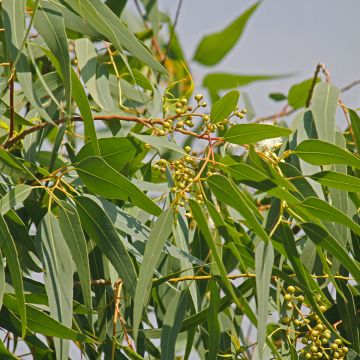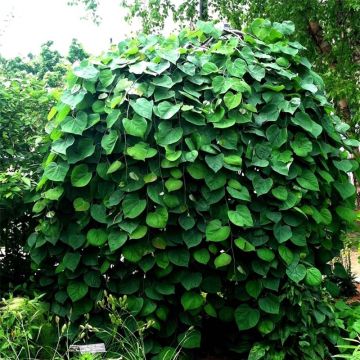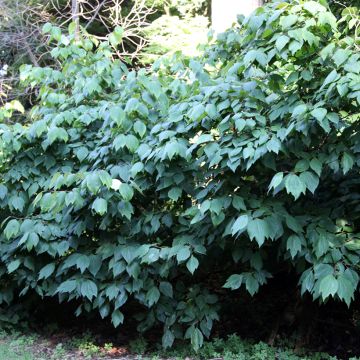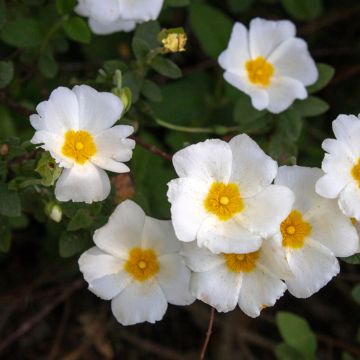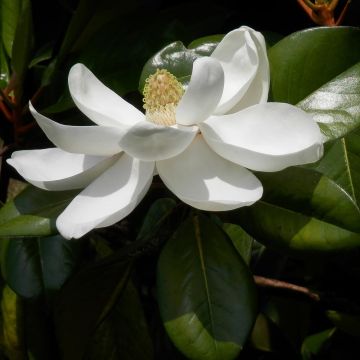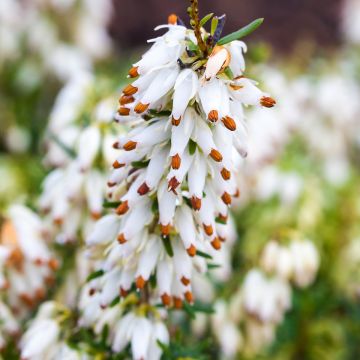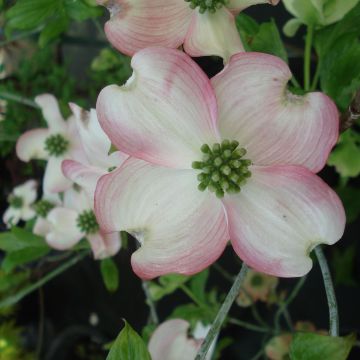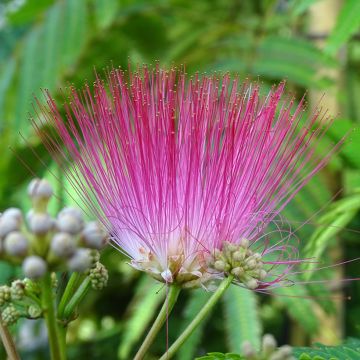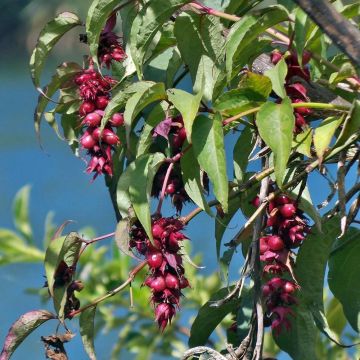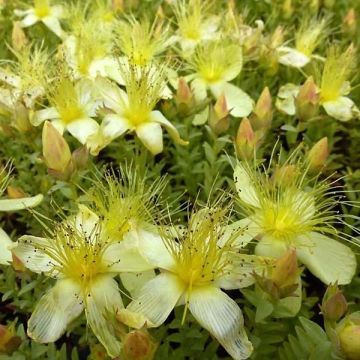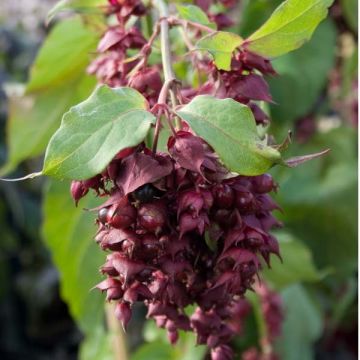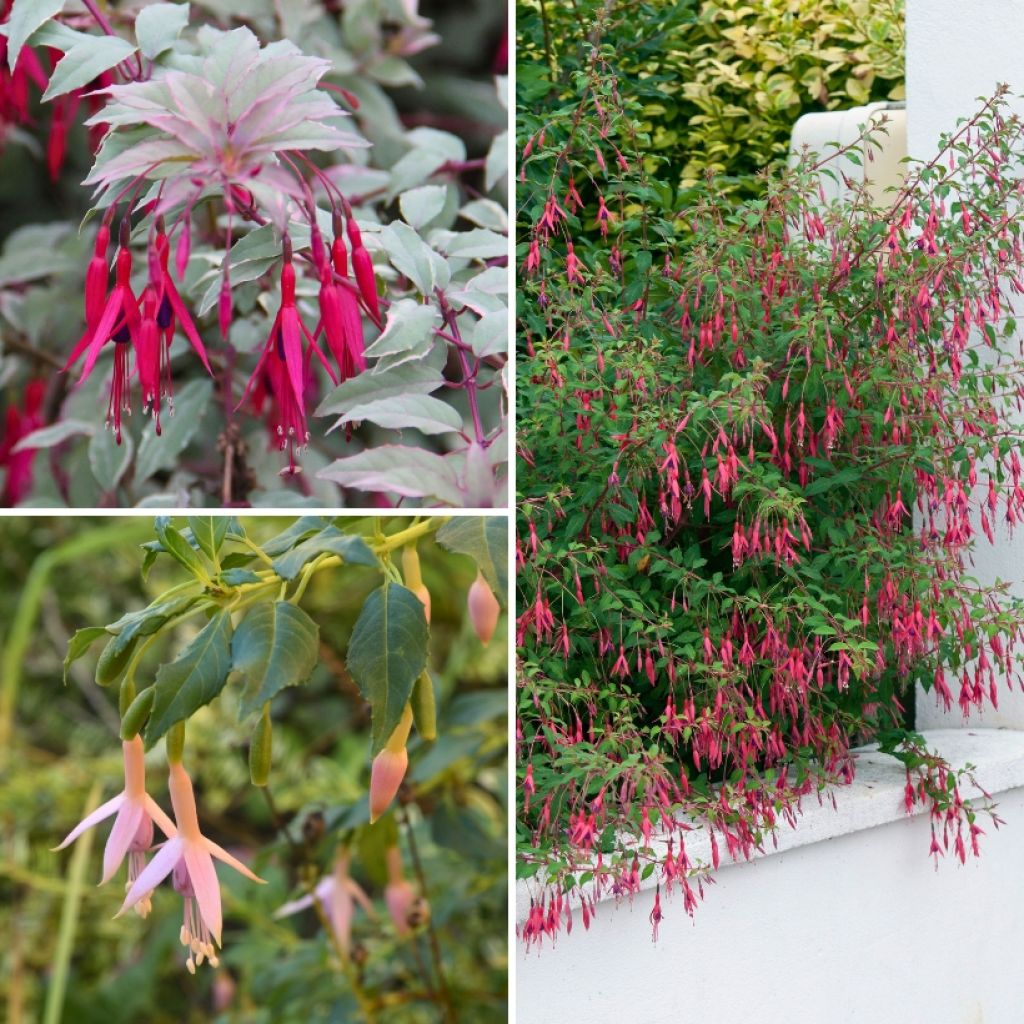

Hardy Shrubby Fuchsias Collection
Hardy Shrubby Fuchsias Collection
Fuchsia magellanica Riccartonii, var. molinae, Versicolor
This plant carries a 24 months recovery warranty
More information
We guarantee the quality of our plants for a full growing cycle, and will replace at our expense any plant that fails to recover under normal climatic and planting conditions.
From €5.90 for pickup delivery and €6.90 for home delivery
Express home delivery from €8.90.
Does this plant fit my garden?
Set up your Plantfit profile →
Collection items (3 plants)
Description
This collection of hardy shrubby Fuchsias brings together three superb varieties of Fuchsia magellanica. These shrubby varieties, known for their better cold resistance, have attractive foliage and numerous pendant tubular flowers, often bicoloured, in shades of red, pink, and white. They flower abundantly from June to October, bringing colour and life to the garden as well as the patio. These fuchsias thrive in a cool, well-drained soil, rich in humus, in a semi-shaded or sunny position that is not scorching.
The collection consists of:
1 Fuchsia magellanica 'Riccartonii': a vigorous variety that easily reaches a height of 1.2 m, with bright red tube-shaped flowers and a violet corolla, and dark green foliage. Flowering from June to October.
1 Fuchsia magellanica var. molinae: a more compact variety, reaching about 1 m in height, with bell-shaped flowers in shades of white and pink. Its foliage is lighter. Flowering from July to September.
1 Fuchsia magellanica Versicolor: delicate bright pink and dark violet flowers, like those of the Fuchsia magellanica, on a beautiful tender green foliage veined with red and irregularly marginated with white. Height up to 1m. Flowering from July to October.
Plant these hardy shrubby fuchsias in spring, in well-drained soil enriched with organic matter (good horticultural compost). Choose a slightly shaded exposure and ensure that the soil does not dry out too much during the entire growth and flowering period. They will look superb in flowerbeds, as a low hedge, or in pots.
In flowerbeds, place the tallest Fuchsia magellanica 'Riccartonii' behind the other two. Position the Fuchsia magellanica 'Versicolor' in the centre and the smaller Fuchsia magellanica var. molinae in the foreground. Maintain a spacing of 60 cm between each plant. Use 3 to 4 plants per m² for a dense and colourful effect.
Pair these fuchsias with hostas, whose luxuriant foliage complements the colourful flowers of the fuchsias. The heuchera, with their colourful leaves, will form a beautiful carpet at the front of your flowerbed. In the background, plant some Hydrangea macrophylla for colour and volume, alternating with male fern plants.
Report an error about the product description
Plant habit
Flowering
Foliage
Botanical data
Fuchsia
magellanica
Riccartonii, var. molinae, Versicolor
Onagraceae
Cultivar or hybrid
Other Shrubs A to Z
Planting and care
Plant your hardy bush fuchsias preferably in spring, in open ground or in pots. They should be placed in shade or partial shade in a cool, rather fertile soil, rich in humus or horticultural compost, with a tendency towards acidity and good drainage. They do not like scorching sun, heatwaves, drought, or waterlogged soil in winter. You can add some gravel to the bottom of the planting hole if your soil is very clayey.
The leaves are deciduous as soon as the temperature drops below -4°C, and the stems wilt at -10°C. If you are in a mild and temperate climate, simply prune the stems by half at the end of autumn. Otherwise, prune them lower and protect the base by mulching before winter. You may prune the stems again in early spring, removing any dry parts. The well-protected base can withstand short frosts of around -12°C.
Planting period
Intended location
Care
This item has not been reviewed yet - be the first to leave a review about it.
Summer-flowering shrubs
Haven't found what you were looking for?
Hardiness is the lowest winter temperature a plant can endure without suffering serious damage or even dying. However, hardiness is affected by location (a sheltered area, such as a patio), protection (winter cover) and soil type (hardiness is improved by well-drained soil).

Photo Sharing Terms & Conditions
In order to encourage gardeners to interact and share their experiences, Promesse de fleurs offers various media enabling content to be uploaded onto its Site - in particular via the ‘Photo sharing’ module.
The User agrees to refrain from:
- Posting any content that is illegal, prejudicial, insulting, racist, inciteful to hatred, revisionist, contrary to public decency, that infringes on privacy or on the privacy rights of third parties, in particular the publicity rights of persons and goods, intellectual property rights, or the right to privacy.
- Submitting content on behalf of a third party;
- Impersonate the identity of a third party and/or publish any personal information about a third party;
In general, the User undertakes to refrain from any unethical behaviour.
All Content (in particular text, comments, files, images, photos, videos, creative works, etc.), which may be subject to property or intellectual property rights, image or other private rights, shall remain the property of the User, subject to the limited rights granted by the terms of the licence granted by Promesse de fleurs as stated below. Users are at liberty to publish or not to publish such Content on the Site, notably via the ‘Photo Sharing’ facility, and accept that this Content shall be made public and freely accessible, notably on the Internet.
Users further acknowledge, undertake to have ,and guarantee that they hold all necessary rights and permissions to publish such material on the Site, in particular with regard to the legislation in force pertaining to any privacy, property, intellectual property, image, or contractual rights, or rights of any other nature. By publishing such Content on the Site, Users acknowledge accepting full liability as publishers of the Content within the meaning of the law, and grant Promesse de fleurs, free of charge, an inclusive, worldwide licence for the said Content for the entire duration of its publication, including all reproduction, representation, up/downloading, displaying, performing, transmission, and storage rights.
Users also grant permission for their name to be linked to the Content and accept that this link may not always be made available.
By engaging in posting material, Users consent to their Content becoming automatically accessible on the Internet, in particular on other sites and/or blogs and/or web pages of the Promesse de fleurs site, including in particular social pages and the Promesse de fleurs catalogue.
Users may secure the removal of entrusted content free of charge by issuing a simple request via our contact form.
The flowering period indicated on our website applies to countries and regions located in USDA zone 8 (France, the United Kingdom, Ireland, the Netherlands, etc.)
It will vary according to where you live:
- In zones 9 to 10 (Italy, Spain, Greece, etc.), flowering will occur about 2 to 4 weeks earlier.
- In zones 6 to 7 (Germany, Poland, Slovenia, and lower mountainous regions), flowering will be delayed by 2 to 3 weeks.
- In zone 5 (Central Europe, Scandinavia), blooming will be delayed by 3 to 5 weeks.
In temperate climates, pruning of spring-flowering shrubs (forsythia, spireas, etc.) should be done just after flowering.
Pruning of summer-flowering shrubs (Indian Lilac, Perovskia, etc.) can be done in winter or spring.
In cold regions as well as with frost-sensitive plants, avoid pruning too early when severe frosts may still occur.
The planting period indicated on our website applies to countries and regions located in USDA zone 8 (France, United Kingdom, Ireland, Netherlands).
It will vary according to where you live:
- In Mediterranean zones (Marseille, Madrid, Milan, etc.), autumn and winter are the best planting periods.
- In continental zones (Strasbourg, Munich, Vienna, etc.), delay planting by 2 to 3 weeks in spring and bring it forward by 2 to 4 weeks in autumn.
- In mountainous regions (the Alps, Pyrenees, Carpathians, etc.), it is best to plant in late spring (May-June) or late summer (August-September).
The harvesting period indicated on our website applies to countries and regions in USDA zone 8 (France, England, Ireland, the Netherlands).
In colder areas (Scandinavia, Poland, Austria...) fruit and vegetable harvests are likely to be delayed by 3-4 weeks.
In warmer areas (Italy, Spain, Greece, etc.), harvesting will probably take place earlier, depending on weather conditions.
The sowing periods indicated on our website apply to countries and regions within USDA Zone 8 (France, UK, Ireland, Netherlands).
In colder areas (Scandinavia, Poland, Austria...), delay any outdoor sowing by 3-4 weeks, or sow under glass.
In warmer climes (Italy, Spain, Greece, etc.), bring outdoor sowing forward by a few weeks.





































